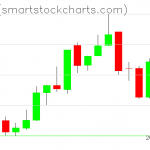Dollar Cost Averaging: Diversification in the Time Domain
 When most people think of diversification, they picture dividing their portfolio among several stocks or asset classes so that they’re if any of their assets sustains a large loss, their portfolio still remains fairly intact. Traditional diversification assumes that we don’t know which stocks will perform well or tank in the future so we spread our risk among several. Dollar cost averaging, on the other hand, can be considered a form of diversification in the time domain as opposed to the asset domain. To put simply, it involves purchasing an investment gradually over time in multiple payments rather than waiting for the “best” time and buying it all at once. Most dollar cost averagers will buy fixed dollar amounts of an asset at set intervals (say $1000 every month) but this isn’t a requirement, strictly speaking.
When most people think of diversification, they picture dividing their portfolio among several stocks or asset classes so that they’re if any of their assets sustains a large loss, their portfolio still remains fairly intact. Traditional diversification assumes that we don’t know which stocks will perform well or tank in the future so we spread our risk among several. Dollar cost averaging, on the other hand, can be considered a form of diversification in the time domain as opposed to the asset domain. To put simply, it involves purchasing an investment gradually over time in multiple payments rather than waiting for the “best” time and buying it all at once. Most dollar cost averagers will buy fixed dollar amounts of an asset at set intervals (say $1000 every month) but this isn’t a requirement, strictly speaking.
Advantages of Dollar Cost Averaging
It’s more natural for people with income
Many people receive paychecks every week or month. Dividend payments from stocks occur every quarter or so. Bond coupons and rental payments from real estate usually come in every month. It’s more natural and manageable, especially for position traders and long-term investors, to buy investments with a portion of their recurring paycheck, dividends, or other royalties than to save it all up and invest in a single large lump sum payment some time in the future.
Market Timing Won’t Make or Break your Investments
When you invest a single lump sum of money at once, you’re at the mercy of the market at that particular moment. You may end up buying the lows of a market pullback or you might get unlucky and buy right before the market dips. With Dollar Cost Averaging, you split your investment capital into chunks and diversify among multiple entry points. This doesn’t mean you can’t use some market timing (like reading the stock charts) to optimize the entry of each chunk of money you invest but it’s wise to set a deadline (for example, investing 10% of your paycheck within a week of receiving it every month with the option to invest earlier if opportunities arise and investing the full 10% by day 7 if it’s not already invested.)
You End Up Buying More Shares When Prices are Low
Suppose you’re committed to buying $3000 in a particular stock or ETF every month. If the investment is trading at $30, you’ll buy 100 shares. At $20, you’ll buy 150 shares. And at $15, you’ll buy 200 shares. While you’re not always buying low (since nobody knows for sure what the lowest price is at least not in retrospect), you do end up buying more shares when the price is low.
Disadvantages of Dollar Cost Averaging
Commissions
If your boss pays you every week and you’re dollar cost averaging your paycheck every single week, you’re making too many trades, IMO. I’d wait and invest once a month instead since the taking advantage of those weekly fluctuations in the market isn’t going to make that big of a difference in most cases and you’ll only pay 1/4 the commissions by investing monthly instead of weekly.
Doesn’t Protect You Against Poor Investments
If you spread your portfolio equally among 10 different investments and one of them collapses, then you’ll lose 10%. But if you put all of your money in that single investment that eventually collapsed, you’d lose all of your money even if you used Dollar Cost Averaging. Even if you bought 1000 shares at $1/share one month and then 100,000 shares at $0.01/share the next month, you’re still gonna lose all of your money when the company goes to 0. Dollar Cost Averaging serves to mitigate some market risk but only after you’ve done your due diligence and identified sensible investments.
Lowers Your Long-Term Returns
All good investments have a positive long-term return. Which means if you buy it all in a lump sum on day 1, you’re statistically more likely to make a larger return than if you were to ease into the investment every month or so over the next year. Now, most of us don’t have the luxury of receiving a huge lump sum of cash and must earn it through employment, dividends, rents, etc. but it is something to consider the next time you receive a windfall. More on this later.
Other Considerations
Dollar Cost Averaging on a Portfolio
I’ve made it dead clear that putting all of your eggs in one basket is not a sound investment strategy (although you probably know that already.) So in reality, the vast majority of us reading this article probably have portfolios of multiple securities. How do we employ Dollar Cost Averaging in a portfolio?
Try Rebalancing by Contribution. Every time you contribute money to a portfolio with multiple stocks and ETFs, you buy the asset(s) whose weight is furthest below their target weights. Suppose you’re equal weighted among 4 different assets in your portfolio and last month, your 4 assets all came in at a market value of $10,000 each. Let’s say next month, your 4 assets have the following market values:
Asset A: $10,500
Asset B: $10,000
Asset C: $10,500
Asset D: $9,500
Let’s say you have $1500 to contribute to the portfolio, so you’d put $500 into Asset B and $1000 in Asset C to make every asset in your portfolio have a market value of $10,500.
Investing a Lump Sum
Occasionally, we’ll receive lump sums of money in our lives that easily dwarf our monthly paychecks. This may include lottery winnings for the lucky few but will likely be attributed to inheritances, bonuses, excess proceeds from selling a house, etc. Should you invest the entire lump sum at once or dollar cost average it in over time?
If you have a fairly solid investment portfolio that is steadily growing over time, the most rational decision would be to invest it all into that portfolio in a single lump sum for maximal long term wealth. Unfortunately, most people in these situations are not psychologically prepared risk investing their large windfall and will end up being paralyzed by indecision or worse, spending it all in a short time.
If you don’t know what I’m talking about, imaging that your current net worth is $100,000 and you suddenly receive a $1 million inheritance. You may entertain the idea of investing that $1 million and making your portfolio $1.1 million but if your portfolio were to lose 10% in the coming year, you would end up losing $110,000, even more than your entire net worth before the windfall. Without knowing what the future holds, it would probably be more tolerable to invest, say, $50,000 to $100,000 of the windfall every month until it’s fully invested rather than plunging the entire $1 million in at once.
Conclusion
Investors and longer term traders can diversify their market timing risk, especially in volatile markets through Dollar Cost Averaging their entry points rather than trying to pick the best time to enter the markets. Since all good investments deliver positive returns in the long run, it’s likely you’ll end up buying higher in the future compared to now. Combine that with higher commissions you’ll pay your broker, Dollar Cost Averaging will result in slightly lower returns in exchange for lower volatility. If you’re investing a lump sum, this is a great alternative to going all in which may keep you up at night. But if you’re investing a portion of every paycheck, this is your best option for growing your wealth over time.



